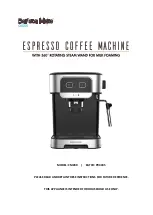
ball, forms more than one ball, or is a ball but not soft and slightly tacky, add 1 teaspoon of water
and allow it to absorb. Add more water if necessary. Provided you have used all of the ingredients
specified in the recipe, measured the ingredients properly, and have a "good” dough ball, you
should achieve a successful load of bread.
When preparing bread in the Fast Bake program, the dough ball will be a very soft, loose ball with
a smooth texture and will be sticky to the touch. When touched it will leave dough on your finger.
n
I N G R E D I E N T S : READ BEFORE SHOPPING
Yeast: The Number One Ingr e d i e n t
For all programs except Fast Bake we used RED STAR
®
Active Dry Yeast when we developed the
bread recipes. However, RED STAR
®
QUICK RISE
™
Yeast may also be used. We found that we did
not have to vary the amount used when we substituted one for the other. When using bread
machine yeast, follow the package instructions.
When developing the fast bake program, we found that Quick•Rise or Bread Machine must be
used. They may be substituted in equal amounts. You will find that this program requires more yeast
than other programs.
A 1/4 ounce package of RED STAR yeast contains approximately 2 1/4 level teaspoons of yeast.
When the yeast is exposed to oxygen, moisture or warmth, the activity of it deteriorates. Therefore,
we recommend storing yeast in an airtight container and refrigerating for up to 6 weeks or freezing
it for up to 6 months. Measure out the amount you need and allow it to come to room temperature
before using it — this takes about 15 minutes.
If you have any doubt regarding the activity of the yeast, you may use one of the following tests to
determine its strength. Each test calls for a different amount of yeast as a base ingredient. This gives
you more bread choices once the test is complete. The yeast mixture should not be used for the fast
bake program.
To test for one package (2 1/4 teaspoons) of RED STAR Active Dry or QUICK•RISE Yeast, use a
l i q u i d measuring cup and fill to the 1/2 cup level with 110°-115°F/43°-46°C water. Stir in 1
t e a s p o o n granulated sugar and 1 package (2 1/4 teaspoons) RED STAR Active Dry or
QUICK•RISE Yeast. Leave your stirring spoon in the cup. Set a timer for 10 minutes. As the yeast
absorbs liquid, it will begin to activate and rise to the surface. If at the end of the 10 minutes the
yeast has multiplied to the 1 cup mark, it is very active. The yeast mixture may be used in your
ToastmasterBread Maker in a recipe that calls for 2 1/4 teaspoons of yeast. Remember to adjust
your recipe for the 1/2 cup of water and 2 1/4 teaspoons of yeast used in the test. The sugar does
not need to be adjusted. To test for 1 1/2 teaspoons of RED STAR Active Dry or QUICK•RISE Yeast,
use a liquid measuring cup and fill to the 1/4 cup level with 110°-115°F/43°-46°C water. Stir in 1
teaspoon granulated sugar and 1 1/2 teaspoons RED STAR Active Dry or QUICK•RISE Yeast.
Leave your stirring spoon in the cup. Set a timer for 10 minutes. As the yeast absorbs liquid, it will
begin to activate and rise to the surface. If at the end of the 10 minutes the yeast has multiplied to
the 1/2 cup mark, it is very active. The yeast mixture may be used in your Toastmaster Bread
Maker in a recipe that calls for 1 1/2 teaspoons or more of yeast. Remember to adjust your recipe
for the 1/4 cup of water and 1 1/2 teaspoons of yeast used in the test. The sugar does not need to
be adjusted.
Flour: Bread Flour is Essential for Br e a d
All types of flour are affected by many factors, such as milling grades, moisture content, length of
storage and manufacturing processes. Adjustments to the recipes may need to be made to compen-
sate for climactic changes in different regions to ensure an excellent loaf.
10











































